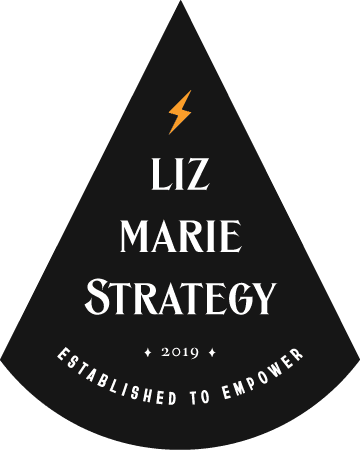Your brand voice is the language, style, and personality that you use to communicate with your audience. And most of you are doing it wrong. 🙂
In this episode of Branding for Badasses, we’re talking about how to create your own brand voice. Your brand voice will help you build a relationship with your audience, clients, and potential customers.
The problem: most people go way too formal or don’t consider the right factors. Some focus too much on personality without factoring in what their audience might expect from them or the context(s) they’re communicating in.
Here are 4 Key Factors to help you figure out your unique brand voice so that you can communicate super effectively with your audience and make them love and TRUST you!
#1 Know your audience and the role you serve for them
Assuming you know who your audience is (if you don’t, check out my video, How to find the PERFECT niche for your brand), you need to know both who you’re talking to AND what your relationship is. Here’s why this is important: you speak differently to the Queen of England vs. your mom vs. your boss vs. your best friend. You use different language, a different manner of speaking, maybe even a different voice depending on who you are talking to. And this is just human nature – it’s all about context. For some of you, there’s another level of code-switching. So, we need to think about:
- Who you’re talking to?
- What might they expect from you?
- What role do you play?
Are you the expert, the educator, the guide, the mentor, the caretaker, a confidant, a friend, a sister? What role are you playing for them in their journey and what might they expect from someone in that role? For example, if you’re the expert, they’d likely expect you to have authority and present things with lots of facts and knowledge. If you’re the caretaker, it might be more soothing and include warm and gentle language. If you’re the best friend, you’d likely use slang, be playful and even call them out on their shit. The tones are super different!
Takeaway #1 What tone would your audience expect from you?
#2 Know your brand personality
I talk about brand personality in almost every video (I even have a whole video on Finding Your Brand Personality). Brand personality pretty much defines everything about how you want to act in your brand; it represents what kind of brand you want to be and what you want to be like.
For example, you’ll be bold and risky if you’re the rebel archetype. You might curse or be aggressive. If you’re the joker, you’d be completely different. As the joker archetype, you’re going to be more humorous, playful, or casual. But, if you’re the ruler, you’re going to be formal, authoritarian, and distant; you don’t want closeness because you want your brand to be perceived as a higher status than your brand, which is common with luxury brands. So, as you can see, the brand personality dictates so much about how you want to communicate.
Sometimes the attributes that you dictate for your brand personality can be directly translated to your brand voice.
Takeaway #2 What do you want to communicate about yourself?

#3 Think Specifics
This is getting into the nitty-gritty of what you do and don’t do as a brand.
I often like to define brand voice on a spectrum. It’s helpful to use these spectrums to find where you stand. Here’s a breakdown of some helpful spectrums to use as a starting point:
Casual < > Formal
Playful < > Serious
Down-to-earth < > Authoritative
Young < > Old
Humble < > Confident
Simple < > Complex
Where do you land on these spectrums? How does that align with who you want to align yourself as? And what does your audience expect from you?
Now, take it a step further and look at the specific do’s and don’ts that you want to include in your brand communication. Here are some to think on:
Do you curse? If you watch any of my videos, you know I cuss all the time. My brand is about being super down-to-earth, and since I curse naturally, I include that in my branding.
Do you use idioms or slang? Do you speak casually and with the same language you do with your friends? Are you keeping up with the “internet talk” (or with the kids, as they say? 😬) Or are you more grammatically correct?
Do you use contractions? Or do you say “cannot” instead of “can’t”?
Do you use commonalities and references, or are you more detached and more of a “brand” than a person in your branding?
Do you make jokes or are you very serious?
Do you use jargon or technical language? Do you simplify it for your audience and just tell it like it is?
These all create a different experience and different perception of your brand. Of course, there’s always more to consider but laying out specifics do’s and don’ts is what you’re looking for!
Takeaway #3 The clearer you are with your do’s and don’t, the clearer your communication style becomes.
#4 Write it down
For me, a brand voice consists of 5 or 6 words that represent the personality I want to convey in my written communication.
Let’s use me as an example. In my actual brand, written in my brand guidelines, I have: quirky, warm, down-to-earth, honest, fearless. Let me know if you think this comes through in my brand voice in my videos!
Once you’ve written down your characteristics, you can practice using language that fits those descriptors. Write some brand messaging, a social media post, an email, or even a little note to a client and try on those characteristics. Want to be informal? Change that “to whom it may concern” to a “hey, what’s up?”!
My favorite trick for most brands is just to write how you would speak. I think this really humanizes brands and that most brands can benefit from being more human and less formal. So instead of worrying about being more “professional” or business-like, focus on being more human!
Context matters!
Just like your role related to that person matters/the relationship with that audience member matters – the context that you’re speaking in matters. The way that you’re going to speak to someone when you’ve fucked up their order and they’re pissed at you is different than how you talk to them when they’re really excited about what you have to offer, or when you’re signing a contract, or when you’re giving a freebie. Every single point in the customer journey has nuances in the context of how you might want to communicate.
So, there’s a place to be more on the serious end of your normal brand voice or more contrite and respectful, just like there’s a place to be more informal and loose. All of your characteristics still have to adapt to that context, or you’re going to have a negative brand experience for your audience.
In conclusion, just like all things branding, finding your brand voice is all about finding that alignment and connection between who you actually are and who your audience is. Once you find those two connect and find that sweet spot, you will be golden! You’ll build trust, connection and deep, deep relationships with your audience.
Your homework is to write down 5 words that capture your unique brand voice! I cant wait to see them!
If you want a little more help with this, download my worksheet on creating your brand voice! It contains lots of words, spectrums, all the things you’ll need to pick from and get a great start on crafting the voice that will be so powerful for your brand.
Until next time, stay badass!
